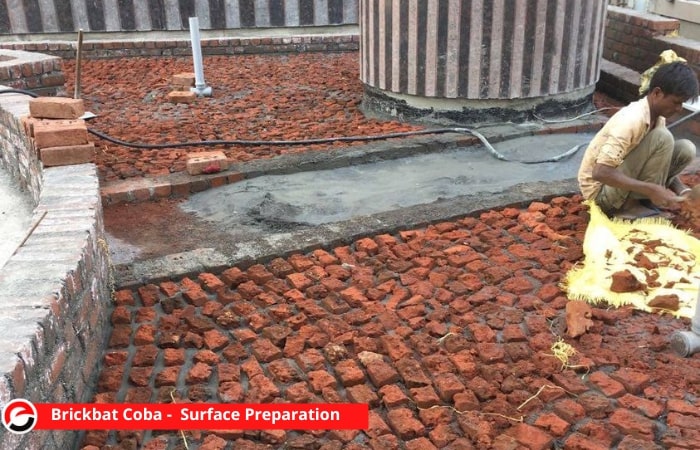Brickbat Coba
Brick bat Coba is a traditional method of waterproofing. It is effective only for a short period but it is good for thermal insulation. These are mainly used in areas having annual rainfall higher than average areas. This proofing is done by providing a slant or tilted slope to the RCC roof so that water will not keep collecting there. Brickbat Coba has both insulations as well as waterproofing properties so for the Roof slab constructed by RCC.

Brickbat Coba Method
The procedure of Brickbat Coba Waterproofing is as follows:
1. Surface Preparation
The surface of the roof slab should be neat and cleaned using a hard wire brush and should be washed with normal water. If there are coatings on the slab they should be removed. The surface where the coating is to be applied should be free from any kind of grease, dust, oil, etc. If there are any structural cracks then remedial measures should be done before applying the coating.

2. Application of Slurry and Base Coat
The cement and water are mixed together to form a slurry of the required consistency. Brushes are used to place the slurry on the dampened surface very carefully. The slurry is placed on the surfaces including the joints between the floor slab and the parapet wall, holes on the surfaces, and joints of pipes in masonry or concrete. The quantity of slurry prescribed is 2.75Kg of cement per Sqm. Half an hour is considered as the pot life of slurry.
3. Placing of Brickbat
Before laying the brickbat are soaked in water at least overnight and at an average thickness of 110mm these are placed over the green mortar. The brickbats are placed at a distance of 15 to 20mm gap and these gaps are filled with cement sand mortar admixed with waterproofing chemical. After finishing the placing the surface should immediately cover with gunny bags if it’s hot and dry weather.
4. Laying of Protective Coat
After laying the top surface of the finished smooth surface is covered with 20mm thick cement sand mortar admixed with a waterproofing chemical. The waterproofing compound as per the IS 2645 is used with the cement water mixture. For 50 kg of grey cement, the waterproofing compound of not more than 3% should be used. The finished surface should be allowed to dry for a while till a string mark can easily be made on the surface when 300mm x 300mm square marks shall be made over the entire surface.
5. Curing
After all the above processes the entire surface should be flooded with water by making bunds with low cement mortar. The curing should be done for a period of 1 to 2 weeks.

Disadvantages of Brickbat Waterproofing
- It adds unnecessary load when used in terrace waterproofing.
- It is impossible to repair.
- Removing the brickbat Coba is time-consuming and even damages the surfaces
- Due to climatic variations, the cracks occur on brickbat Coba so easily.
Also Read: Complete guide on Soak Pit Design


Leave a comment